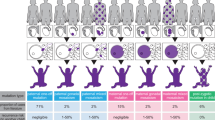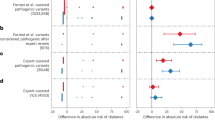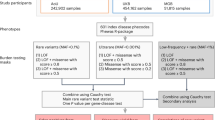Abstract
Some diseases are due to germline mutations in predisposing genes, such as cancer family syndromes. Precise estimation of the age-specific cumulative risk (penetrance) for mutation carriers is essential for defining prevention strategies. The genotype-restricted likelihood (GRL) method is aimed at estimating penetrance from multiple case families with such a mutation. In this paper, we proposed an extension of the GRL to account for multiple trait disease and to allow for a parent-of-origin effect. Using simulations of pedigrees, we studied the properties of this method and the effect of departures from underlying hypotheses, misspecification of disease incidence in the general population or misspecification of the index case, and penetrance heterogeneity. In contrast with the previous version of the GRL, accounting for multiple trait disease allowed unbiased estimation of penetrance. We also showed that accounting for a parent-of-origin effect allowed a powerful test for detecting this effect. We found that the GRL method was robust to misspecification of disease incidence in the population, but that misspecification of the index case induced a bias in some situations for which we proposed efficient corrections. When ignoring heterogeneity, the penetrance estimate was biased toward that of the highest risk individuals. A homogeneity test performed by stratifying the families according to the number of affected members was shown to have low power and seems useless for detecting such heterogeneity. These extensions are essential to better estimate the risk of diseases and to provide valid recommendations for the management of patients.
Similar content being viewed by others
Log in or create a free account to read this content
Gain free access to this article, as well as selected content from this journal and more on nature.com
or
References
Carayol J, Khlat M, Maccario J, Bonaiti-Pellie C : Hereditary non-polyposis colorectal cancer: current risks of colorectal cancer largely overestimated. J Med Genet 2002; 39: 335–339.
Eisinger F, Bressac B, Castaigne D et al: Identification et prise en charge des prédispositions héréditaires aux cancers du sein et de l’ovaire. Bull Cancer 2004; 91: 219–237.
Lindor NM, Petersen GM, Hadley DW et al: Recommendations for the care of individuals with an inherited predisposition to Lynch syndrome: a systematic review. JAMA 2006; 296: 1507–1517.
Carayol J, Bonaiti-Pellie C : Estimating penetrance from family data using a retrospective likelihood when ascertainment depends on genotype and age of onset. Genet Epidemiol 2004; 27: 109–117.
Shete S, Yu R : Genetic imprinting analysis for alcoholism genes using variance components approach. BMC Genet 2005; 6 (Suppl 1): S161.
Green J, O’Driscoll M, Barnes A et al: Impact of gender and parent of origin on the phenotypic expression of hereditary nonpolyposis colorectal cancer in a large Newfoundland kindred with a common MSH2 mutation. Dis Colon Rectum 2002; 45: 1223–1232.
Gorlova OY, Lei L, Zhu D et al: Imprinting detection by extending a regression-based QTL analysis method. Hum Genet 2007; 122: 159–174.
Klutz M, Brockmann D, Lohmann DR : A parent-of-origin effect in two families with retinoblastoma is associated with a distinct splice mutation in the RB1 gene. Am J Hum Genet 2002; 71: 174–179.
Alarcon F, Lasset C, Carayol J et al: Estimating cancer risk in HNPCC by the GRL method. Eur J Hum Genet 2007; 15: 831–836.
De Angelis R, Capocaccia R, Hakulinen T, Soderman B, Verdecchia A : Mixture models for cancer survival analysis: application to population-based data with covariates. Stat Med 1999; 18: 441–454.
Elston RC, Stewart J : A general model for the genetic analysis of pedigree data. Hum Hered 1971; 21: 523–542.
Thompson E : Pedigree Analysis in Human Pedigrees. Baltimore: Johns Hopkins University Press, 1986.
Zhu C, Byrd RH, Nocedal J : L-BFGS-B: Algorithm 778: L-BFGS-B, FORTRAN routines for large scale bound constrained optimization. ACM Trans Math Softw 1997; 23: 550–560.
Bonadona V, Bonaïti B, Olschwang S et al: Cancer risks associated with germline mutations in MLH1, MSH2 and MSH6 genes in Lynch syndrome: results from the large nationwide French study ERISCAM. Submitted for publication.
Dunlop MG, Farrington SM, Carothers AD et al: Cancer risk associated with germline DNA mismatch repair gene mutations. Hum Mol Genet 1997; 6: 105–110.
Quehenberger F, Vasen HF, van Houwelingen HC : Risk of colorectal and endometrial cancer for carriers of mutations of the hMLH1 and hMSH2 gene: correction for ascertainment. J Med Genet 2005; 42: 491–496.
Jenkins MA, Baglietto L, Dowty JG et al: Cancer risks for mismatch repair gene mutation carriers: a population-based early onset case-family study. Clin Gastroenterol Hepatol 2006; 4: 489–498.
Watson P, Vasen HF, Mecklin JP et al: The risk of extra-colonic, extra-endometrial cancer in the Lynch syndrome. Int J Cancer 2008; 123: 444–449.
Schwartz GF, Hughes KS, Lynch HT et al: Proceedings of the international consensus conference on breast cancer risk, genetics, & risk management, April, 2007. Breast J 2009; 15: 4–16.
Lynch HT, Lynch JF, Lynch PM, Attard T : Hereditary colorectal cancer syndromes: molecular genetics, genetic counseling, diagnosis and management. Fam Cancer 2008; 7: 27–39.
Kraft P, Thomas DC : Bias and efficiency in family-based gene-characterization studies: conditional, prospective, retrospective, and joint likelihoods. Am J Hum Genet 2000; 66: 1119–1131.
Choi YH, Kopciuk KA, Briollais L : Estimating disease risk associated with mutated genes in family-based designs. Hum Hered 2008; 66: 238–251.
Belot A, Grosclaude P, Bossard N et al: Cancer incidence and mortality in France over the period 1980–2005. Rev Epidemiol Sante Publique 2008; 56: 159–175.
Antoniou AC, Pharoah PD, McMullan G et al: A comprehensive model for familial breast cancer incorporating BRCA1, BRCA2 and other genes. Br J Cancer 2002; 86: 76–83.
Antoniou AC, Spurdle AB, Sinilnikova OM et al: Common breast cancer-predisposition alleles are associated with breast cancer risk in BRCA1 and BRCA2 mutation carriers. Am J Hum Genet 2008; 82: 937–948.
Antoniou AC, Sinilnikova OM, Simard J et al: RAD51 135G-->C modifies breast cancer risk among BRCA2 mutation carriers: results from a combined analysis of 19 studies. Am J Hum Genet 2007; 81: 1186–1200.
Carroll RJ, Gail MH, Benichou J, Pee D : Score tests for familial correlation in genotyped-proband designs. Genet Epidemiol 2000; 18: 293–306.
Li H, Thompson E : Semiparametric estimation of major gene and family-specific random effects for age of onset. Biometrics 1997; 53: 282–293.
Stoffel E, Mukherjee B, Raymond VM et al: Calculation of risk of colorectal and endometrial cancer among patients with Lynch syndrome. Gastroenterology 2009; 137: 1621–1627.
Alarcon F, Bourgain C, Gauthier-Villars M, Plante-Bordeneuve V, Stoppa-Lyonnet D, Bonaiti-Pellie C : PEL: an unbiased method for estimating age-dependent genetic disease risk from pedigree data unselected for family history. Genet Epidemiol 2009; 33: 379–385.
Author information
Authors and Affiliations
Corresponding author
Ethics declarations
Competing interests
The authors declare no conflict of interest.
APPENDIX
APPENDIX
Example of misspecification of the index case
In 2005, a woman was affected by colorectal cancer at age 52 years and died 2 years later from ovarian cancer (case 1). Nobody suspected Lynch syndrome at that time although one of her uncle, currently aged 70 years, was affected at age 45 years by colorectal cancer (case 2). In 2009, the brother of the latter, aged 71 years, also developed colorectal cancer (case 3). The sister of case 1 suspected a hereditary syndrome and asked for genetic counselling. As case 1 was not available any more and case 3 could be a sporadic case because of late-onset diagnosis, the geneticist proposed genetic testing of case 2. Therefore, case 2 was designed as the index case although case 3 was obviously the incident case that would have been the ‘natural’ index.
Why should this choice induce a bias in the analysis? As the GRL is conditioned not only on the phenotypes of family members, but also on the genotype of the index case, the choice of case 2 as the index case ‘cancels’ his contribution to the likelihood and replaces it by the contribution of case 3. As case 3 was affected at an older age than case 2, this tends to overestimate age of onset and to decrease the penetrance estimate.
Rights and permissions
About this article
Cite this article
Bonaïti, B., Bonadona, V., Perdry, H. et al. Estimating penetrance from multiple case families with predisposing mutations: extension of the ‘genotype-restricted likelihood’ (GRL) method. Eur J Hum Genet 19, 173–179 (2011). https://doi.org/10.1038/ejhg.2010.158
Received:
Revised:
Accepted:
Published:
Issue date:
DOI: https://doi.org/10.1038/ejhg.2010.158
Keywords
This article is cited by
-
New classification of endometrial cancers: the development and potential applications of genomic-based classification in research and clinical care
Gynecologic Oncology Research and Practice (2016)



